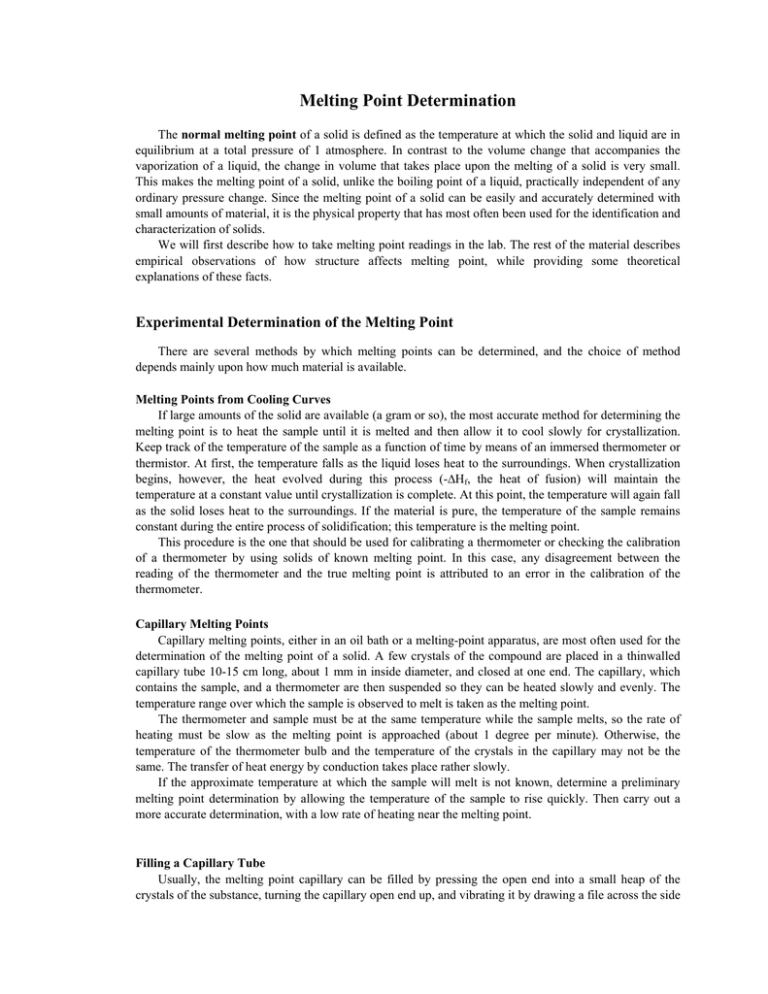Melting Point Determination
advertisement

Melting Point Determination The normal melting point of a solid is defined as the temperature at which the solid and liquid are in equilibrium at a total pressure of 1 atmosphere. In contrast to the volume change that accompanies the vaporization of a liquid, the change in volume that takes place upon the melting of a solid is very small. This makes the melting point of a solid, unlike the boiling point of a liquid, practically independent of any ordinary pressure change. Since the melting point of a solid can be easily and accurately determined with small amounts of material, it is the physical property that has most often been used for the identification and characterization of solids. We will first describe how to take melting point readings in the lab. The rest of the material describes empirical observations of how structure affects melting point, while providing some theoretical explanations of these facts. Experimental Determination of the Melting Point There are several methods by which melting points can be determined, and the choice of method depends mainly upon how much material is available. Melting Points from Cooling Curves If large amounts of the solid are available (a gram or so), the most accurate method for determining the melting point is to heat the sample until it is melted and then allow it to cool slowly for crystallization. Keep track of the temperature of the sample as a function of time by means of an immersed thermometer or thermistor. At first, the temperature falls as the liquid loses heat to the surroundings. When crystallization begins, however, the heat evolved during this process (-∆Ηf, the heat of fusion) will maintain the temperature at a constant value until crystallization is complete. At this point, the temperature will again fall as the solid loses heat to the surroundings. If the material is pure, the temperature of the sample remains constant during the entire process of solidification; this temperature is the melting point. This procedure is the one that should be used for calibrating a thermometer or checking the calibration of a thermometer by using solids of known melting point. In this case, any disagreement between the reading of the thermometer and the true melting point is attributed to an error in the calibration of the thermometer. Capillary Melting Points Capillary melting points, either in an oil bath or a melting-point apparatus, are most often used for the determination of the melting point of a solid. A few crystals of the compound are placed in a thinwalled capillary tube 10-15 cm long, about 1 mm in inside diameter, and closed at one end. The capillary, which contains the sample, and a thermometer are then suspended so they can be heated slowly and evenly. The temperature range over which the sample is observed to melt is taken as the melting point. The thermometer and sample must be at the same temperature while the sample melts, so the rate of heating must be slow as the melting point is approached (about 1 degree per minute). Otherwise, the temperature of the thermometer bulb and the temperature of the crystals in the capillary may not be the same. The transfer of heat energy by conduction takes place rather slowly. If the approximate temperature at which the sample will melt is not known, determine a preliminary melting point determination by allowing the temperature of the sample to rise quickly. Then carry out a more accurate determination, with a low rate of heating near the melting point. Filling a Capillary Tube Usually, the melting point capillary can be filled by pressing the open end into a small heap of the crystals of the substance, turning the capillary open end up, and vibrating it by drawing a file across the side to rattle the crystals down into the bottom. If filing does not work, drop the tube, open end up, down a length of glass tubing about 1 cm in diameter (or a long condenser) onto a hard surface such as a porcelain sink, stone desk top, or the iron base of a ring stand. The solid should be tightly packed to a depth of 2-3 mm. A variety of oil baths can be used in a melting point determination, as well as in a boiling point determination. The simplest use a burner flame and depend upon convection for mixing; the more elaborate and accurate use an electric immersion heater and are stirred. It is easy to heat at a low and steady rate with an electric heater, but almost impossible with a flame. When an oil bath is used, the capillary can be fastened to the thermometer by means of a small slice of rubber tubing used as a rubber band (see Figure below). Arrangement of sample and determination thermometer for melting point There is also a type of melting point apparatus in which the sample and thermometer are both supported in an electrically heated metal block and the sample in the capillary can be observed through a magnifying glass. Usually you can heat the block rapidly when the temperature is well below the melting point, and slowly as the melting point is approached. If a compound begins to decompose near the melting point, the capillary with the sample should be placed in the bath after the temperature has been raised to within 6 or 10 degrees of the expected melting point, so as to minimize the length of time that the sample is heated. Capillary melting points are properly compared with one another, but occasionally they are considerably different from melting points determined from cooling curves. Micro Hot-Stage Melting Points A quick and easy method to determine the melting point of a solid is to heat a few crystals of the sample between a pair of microscope cover glasses on an electrically heated metal block while observing the crystals with the aid of a magnifying glass. This method requires as little as a single crystal and it is very convenient. Unfortunately, hot stage melting points are inherently too high. Complete thermal equilibrium between the sample, block, and thermometer is not possible, since the thermometer is inside the block and the sample is on the surface, exposed to the cooler atmosphere. For this reason, observed block melting points often appear to be higher than capillary melting points; the higher the melting point, the greater the difference. However, a melting point quickly determined on a block can serve as an approximate melting point for the determination of a capillary melting point. Melting Ranges Although there should be a single temperature at which a pure solid and a liquid are in equilibrium, most samples appear to melt over a small temperature range. This happens because, with capillary or block melting points, the temperature of the bath or block rises a little during the time it takes the sample to melt. The presence of impurities in the sample can also cause the sample to melt over a range of temperatures. Thus, the “melting point” will usually be reported as a melting range, the temperatures between which the sample melted. The Melting Point as a Criterion of Purity A dilute solution of a liquid begins to freeze at a temperature somewhat lower than the freezing point of the pure liquid. The presence of an impurity causes a reduction of the freezing point of the sample. As the pure solvent crystallizes from solution, the concentration of the impurity must increase and the freezing point of the solution must fall. Thus, a sharp melting point (actually, a melting range of less than about 1°C) is often taken as evidence that the sample is fairly pure, and a wide melting range is evidence that it is not pure. The Melting Point as a Means of Identification and Characterization If two samples have different melting points, their molecules must differ either in structure or in configuration. They must be either structural isomers or diastereomers. If the melting points of two samples are the same, the structures of their molecules must be the same, although they might have enantiomeric configurations. These statements apply only to pure substances, and do not take into account the fact that some substances can exist in different crystalline forms that have different melting points. Mixture Melting Points Mixtures of different substances generally melt over a range of temperatures, and melting is usually complete at a temperature that is below the melting point of at least one of the components. Thus, the nonidentity of two substances of the same melting point can often be established by determining that the melting point of a mixtures of the two is depressed. If each individual sample melts "sharply" (and at the same temperature, of course), and if an intimate mixture of the two, made by rubbing approximately equal amounts together, melts over a wide range, the two substances are not the same. Usually, however, you wish to establish the identity rather than the nonidentity of two samples, so it is unfortunate that the converse is not always true: the absence of a depression of the melting point or of a wide melting range of the mixture is not certain evidence that the two substances are identical in molecular structure and configuration. Melting Point and Molecular Structure Systematic variations of melting point with changes in structure are not as obvious or predictable as are the variations in boiling point. Molecular Weight Although melting points do generally increase with increasing molecular weight, the first members of homologous series (compounds differing by only a CH2) often have melting points that are considerably different from what would be expected on the basis of the behavior of the higher homology In some homologous series of straight-chain aliphatic compounds, melting points alternate: the melting point of successive members of the series is higher or lower than that of the previous member, depending on whether the number of carbon atoms is even or odd. Sometimes, as with the normal alkanes, the melting points of successive members of the series always increase, but by a larger or smaller amount, depending upon whether the number of carbons is even or odd. Polarity As with boiling points, compounds with polar functional groups generally have higher melting points than compounds with nonpolar functional groups. In contrast to the case with boiling points, highly branched or cyclic molecules (relatively symmetrical molecules) tend to have higher melting points than their straight-chain isomers. The combined effects of branching or the presence of rings, then, are to reduce the range of temperature over which the liquid can exist at a vapor pressure of less than 760 Torr. In extreme cases, a liquid range does not exist at a vapor pressure of less than 760 Torr; at atmospheric pressure, the substance will sublime without melting. Hexachloroethane and perfluoro-cyclohexane behave in this way.




